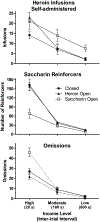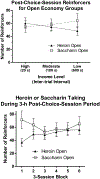Heroin choice depends on income level and economy type
- PMID: 31993695
- PMCID: PMC7196508
- DOI: 10.1007/s00213-020-05471-6
Heroin choice depends on income level and economy type
Abstract
Rationale: In a previous study, investigating choice between heroin and a non-drug alternative in animals and reductions in income (i.e., choices/day) caused the percentage of income spent on heroin to progressively decrease. In contrast, another study found that humans with opioid use disorder spent the majority of their income on heroin even though they had little income. Comparison of these two studies suggests that the seemingly conflicting results could be explained by differences in the underlying economy types of the choice alternatives.
Objective: The present experiment tested the hypothesis that the effect of income changes on choice between heroin and a non-drug alternative depends on economy type.
Methods: Rats chose between heroin and saccharin under three income levels. For the Closed group, the choice session was the only opportunity to obtain these reinforcers. For the Heroin Open group and the Saccharin Open group, choice sessions were followed by 3-h periods of unlimited access to heroin or saccharin, respectively.
Results: As income decreased, the Closed and Heroin Open groups, but not the Saccharin Open group, spent an increasingly greater percentage of income on saccharin than on heroin. The Saccharin Open group, compared to the other groups, spent a greater percentage of income on heroin as income decreased.
Conclusions: Results confirm that the effects of income and economy type can interact and this may explain the apparently discrepant results of earlier studies. More generally, findings suggest that situations where heroin choice has little consequence for consumption of non-drug alternatives may promote heroin use.
Keywords: Behavioral economics; Choice; Economy type; Heroin; Income; Rats.
Figures




Similar articles
-
A Review of Behavioral Economic Manipulations Affecting Drug versus Nondrug Choice in Rats.Perspect Behav Sci. 2025 Apr 7;48(2):341-366. doi: 10.1007/s40614-025-00445-5. eCollection 2025 Jun. Perspect Behav Sci. 2025. PMID: 40520583 Free PMC article. Review.
-
The effect of economy type on demand and preference for cocaine and saccharin in rats.Drug Alcohol Depend. 2018 Nov 1;192:150-157. doi: 10.1016/j.drugalcdep.2018.08.005. Epub 2018 Sep 18. Drug Alcohol Depend. 2018. PMID: 30257224 Free PMC article.
-
The effect of economy type on heroin and saccharin essential value.Exp Clin Psychopharmacol. 2019 Dec;27(6):598-608. doi: 10.1037/pha0000277. Epub 2019 Mar 21. Exp Clin Psychopharmacol. 2019. PMID: 30896241 Free PMC article.
-
Heroin and saccharin demand and preference in rats.Drug Alcohol Depend. 2017 Sep 1;178:87-93. doi: 10.1016/j.drugalcdep.2017.04.031. Epub 2017 Jun 13. Drug Alcohol Depend. 2017. PMID: 28645064 Free PMC article.
-
The effect of economy type on reinforcer value.Behav Processes. 2019 May;162:20-28. doi: 10.1016/j.beproc.2019.01.008. Epub 2019 Jan 24. Behav Processes. 2019. PMID: 30685410 Free PMC article. Review.
Cited by
-
A Review of Behavioral Economic Manipulations Affecting Drug versus Nondrug Choice in Rats.Perspect Behav Sci. 2025 Apr 7;48(2):341-366. doi: 10.1007/s40614-025-00445-5. eCollection 2025 Jun. Perspect Behav Sci. 2025. PMID: 40520583 Free PMC article. Review.
-
Validation of drug-nondrug choice procedure to model maladaptive behavioural allocation to opioid use in rats.Addict Biol. 2024 Oct;29(10):e13442. doi: 10.1111/adb.13442. Addict Biol. 2024. PMID: 39380306 Free PMC article.
-
Cocaine and heroin interact differently with nondrug reinforcers in a choice situation.Exp Clin Psychopharmacol. 2024 Apr;32(2):158-172. doi: 10.1037/pha0000674. Epub 2023 Aug 3. Exp Clin Psychopharmacol. 2024. PMID: 37535523 Free PMC article.
-
An investigation of economic interactions between social reinforcement and heroin or cocaine in rats.Behav Pharmacol. 2024 Dec 1;35(8):442-452. doi: 10.1097/FBP.0000000000000798. Epub 2024 Oct 15. Behav Pharmacol. 2024. PMID: 39421898
References
-
- Ahmed SH, Lenoir M, Guillem K (2013) Neurobiology of addiction versus drug use driven by lack of choice. Current Opin Neurobiol 23:581–587. - PubMed
-
- Ahmed SH (2018) Trying to make sense of rodents’ drug choice behavior. Prog Neuro-Psychopharmacol Biol Psychiatry 87:3–10. - PubMed
-
- Benjamini Y, Hochberg Y (1995) Controlling the false discovery rate: a practical and powerful approach to multiple testing. J Royal Stat Soc 57:289–300.
MeSH terms
Substances
Grants and funding
LinkOut - more resources
Full Text Sources
Research Materials

